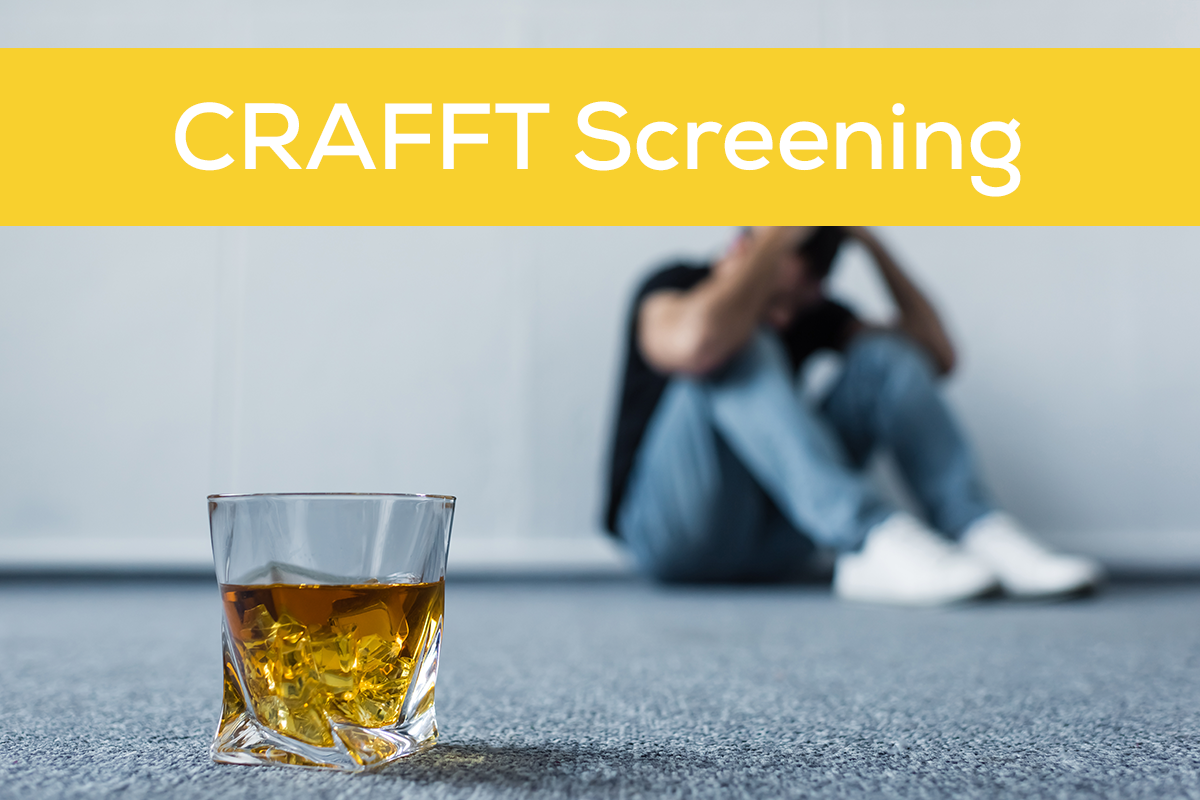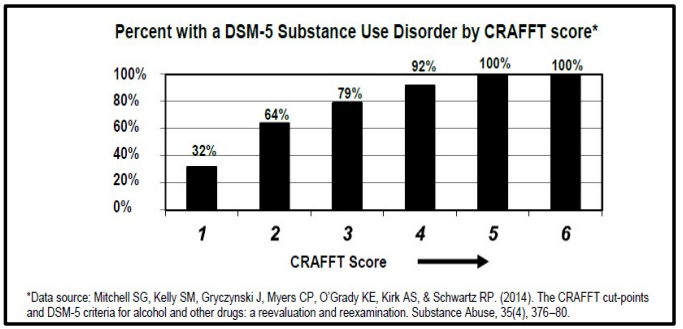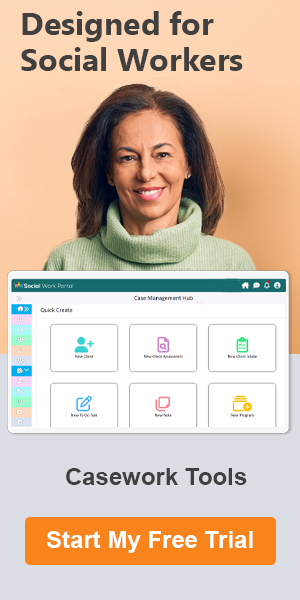2024 Job Aid | How to Use the CRAFFT Screening Tool
Top 2024 Guide | Everything You Need to Know About Using the CRAFFT Questionnaire for Substance Abuse
Many drug and alcohol risk assessments address adult substance abuse, but unfortunately, adolescents also suffer from these same addictions. Between 2019 and 2020, deaths from drug overdoses among adolescents nearly doubled, and in 2021, 32% of high school students admitted to the use of tobacco, marijuana, or alcohol or misusing prescription opioids.
Substance abuse screenings designed for adults may not be well suited to use with adolescents, which was why the CRAFFT screening tool was created to allow for early screenings which can alert healthcare providers and parents to life-saving interventions.

CRAFFT Screen for Alcohol & Drug Use in Adolescents
The CRAFFT substance abuse screening tool was specifically designed for adolescents and young people (aged 12-21) by John R Knight, MD, and colleagues at the Center for Adolescent Behavioral Health Research (CABHRe).
Not only is the CRAFFT screening interview well-respected, but it’s also recommended by the American Academy of Pediatrics’ Bright Futures Guidelines for preventive care screenings and well-visits.
In the sections below, we’ll answer, “What does CRAFFT stand for” as well as go through the CRAFFT meaning, and how to read a CRAFFT screening tool PDF score.
See Also: CAGE Assessment and Screening Tool Guide
Table of Contents: CRAFFT Screening Tool
Keep on scrolling down this page to read each section or click any link below to go directly to that section.
- What Is the CRAFFT Screening Tool?
- What Does CRAFFT Stand For?
- How Is the CRAFFT Screen for Drugs & Alcohol Used?
- Questions Asked in the CRAFFT Questionnaire
- How to Evaluate a CRAFFT Score
- What Is the CRAFFT+N Screening?
- Conclusion | How to Use the CRAFFT Screening Tool
- FAQ | CRAFFT Questionnaire Explained
Don’t Miss: Top Depression and Anxiety Questionnaire
Do you have any feedback about the CRAFT assessment tool being used at your organization? Have you had a positive or negative experience using CRAFFT 2.1 screening tools? If so, contact the Social Work Portal Team to let us know.
What Is the CRAFFT Screening Tool?
The CRAFFT substance abuse screening tool is a questionnaire designed for adolescents between the ages of 12 and 21. It was fashioned after the CAGE adult alcohol screening and tailored to a younger age group.
The CRAFFT form includes questions related to drug use in addition to alcohol use. There is also a version called CRAFFT+N that includes nicotine and tobacco use.
The current version of this universal assessment for substance abuse is the CRAFFT 2.1 screening tool and CRAFFT+N 2.1 tool.
When researching CRAFFT meaning, you’ll find that one of the features that are unique from some adult substance abuse tests is that it addresses substance-related driving risk and the risk of being a passenger in a car with an impaired driver.
Two Versions of the CRAFFT Screening Test
There are two versions of the CRAFFT questions. One is a clinician-administered version, and the other is a self-administered version.
The CRAFFT website recommends using the self-administered version of the CRAFFT screening form if possible because “research has shown that adolescents report greater comfort and the likelihood of honesty with self-administered questionnaires.”
Related: How Do Health Care Workers Use Therapy Billing Codes?
Do you have any questions about the CRAFFT questionnaire PDF, the CRAFT substance abuse screening tool, or where to find a CRAFFT screening tool for adults? If so, contact the Social Work Portal Team.
What Does CRAFFT Stand For? Why is it Important?
The acronym “CRAFFT” in the CRAFFT alcohol screening and drug screening comes from keywords that are the focus of questions 4 through 9 in the survey.
These terms are:
- Car
- Relax
- Alone
- Forget
- Family/Friends
- Trouble
We’ll get into the full CRAFFT assessment substance abuse questionnaire shortly, and you can see how these words are used in each question.
Popular Article: Overview of the PHQ4 Test & PHQ-4 Scoring
How Is the CRAFFT Screen for Drugs & Alcohol Used?
The CRAFFT screening questions are used in many settings to help identify substance-related problems so treatment can be offered as soon as possible. Many busy medical and community health agencies use the CRAFFT survey as a quick and effective tool to identify substance use issues.
The CRAFFT screening interview helps to identify the following in youth:
- Substance use (alcohol, marijuana, drugs)
- Substance-related riding/driving risk
- Substance use disorder
The Substance Abuse and Mental Health Services Administration (SAMHSA) identifies substance use disorders as the recurrent use of alcohol and/or drugs that causes “clinically significant” impairment. This impairment can include disability and health problems, and issues meeting responsibilities at school, work, or home.
Read More: Depression Questionnaire and Scoring Guide
Do you have any questions about the CRAFT assessment tool, how to read the CRAFFT alcohol screening, or the CRAFFT screening tool meaning? If so, contact the Social Work Portal Team.
Questions Asked in the CRAFFT Questionnaire
The CRAFFT substance abuse screening test has nine questions in total that are divided into two sections. The first section asks the individual to give a number of days that they used various substances within the past year. This section comprises questions 1-3.
The second section of the CRAFFT assessment contains Yes/No questions that the individual will answer about activities that they have done or are doing. This section comprises questions 4-9.
The full CRAFFT screening tool PDF can be downloaded in multiple languages from CRAFFT.org. Below, are the nine questions asked in the CRAFFT questionnaire (self-assessment version).
During the Past 12 months, on how many days did you:
- Drink more than a few sips of beer, wine, or any drink containing alcohol? (Put “0” if none.)
- Use any marijuana (cannabis, weed, oil, wax, or hash by smoking, vaping, dabbing, or in edibles) or “synthetic marijuana” (like “K2,” “Spice”)? (Put “0” if none.)
- Use anything else to get high (like other illegal drugs, pills, prescription or over-the-counter medications, and things that you sniff, huff, vape, or inject)? (Put “0” if none.)
READ THESE INSTRUCTIONS BEFORE CONTINUING:
- If you put “0” in ALL of the boxes above, ANSWER QUESTION 4, THEN STOP.
- If you put “1” or higher in ANY of the boxes above, ANSWER QUESTIONS 4-9.
Answer “No” or “Yes” for each question.
- Have you ever ridden in a CAR driven by someone (including yourself) who was “high” or had been using alcohol or drugs?
- Do you ever use alcohol or drugs to RELAX, feel better about yourself, or fit in?
- Do you ever use alcohol or drugs while you are by yourself, or ALONE?
- Do you ever FORGET things you did while using alcohol or drugs?
- Do your FAMILY or FRIENDS ever tell you that you should cut down on your drinking or drug use?
- Have you ever gotten into TROUBLE while you were using alcohol or drugs?
Related: What Are the Best Screening Tools for Depression and Anxiety?
Do you have any questions about the CRAFFT screening tool PDF or how to score a CRAFFT screen? If so, contact the Social Work Portal Team.
How to Evaluate a CRAFFT Score
For the CRAFFT score evaluation, you’ll be looking at the scoring of the Yes/No questions, which are questions 4-9. For each “No” answer, you would score a “0” and for each “Yes” answer, you would score a “1” for the CRAFFT assessment.
For the CRAFFT questionnaire interpretation, the standard is to look for the likelihood that the adolescent meets the criteria for a DSM-5 Substance Use Disorder (SUD) of any level (mild, moderate, severe).
The DSM-5 is the Diagnostic and Statistical Manual of Mental Disorders, Fifth edition.

CRAFFT Screen Score Bar Chart from CRAFFT.org
A score of 2 on the CRAFFT screening test is considered a cut-off where the likelihood that the adolescent has a substance use issue outweighs the likelihood that they do not.
The CRAFFT questionnaire scoring and likelihood percentage of the youth having a DSM-5 Substance Use Disorder is as follows:
- A score of 1: 32% likelihood
- A score of 2: 64% likelihood
- A score of 3: 79% likelihood
- A score of 4: 92% likelihood
- A score of 5 or 6: 100% likelihood
Don’t Miss: Popular Social Work Case Notes Formats
Do you have any questions about how to score a CRAFFT screening tool PDF or how to use the CRAFT alcohol assessment? If so, contact the Social Work Portal Team.
What Is the CRAFFT+N Screening?
The difference between the CRAFFT questionnaire and the CRAFFT+N questionnaire is that the CRAFFT+N adds several additional questions related to nicotine and tobacco use.
In the first section of the CRAFFT questions, there is a fourth question added, which asks the adolescent to answer how many days in the last year did they:
Use a vaping device* containing nicotine and/or flavors, or use any tobacco products†?
*Such as e-cigs, mods, pod devices like JUUL, disposable vapes like Puff Bar, vape pens, or e-hookahs. †Cigarettes, cigars, cigarillos, hookahs, chewing tobacco, snuff, snus, dissolvables, or nicotine pouches.
If the youth answers anything other than 0 days, then they will complete 10 more questions, which ask them to respond yes or no to various nicotine and tobacco-related experiences.
Popular Article: What Social Worker Intake Form Types Are Used the Most by Social Workers?
Conclusion | How to Use the CRAFFT Screening Tool
Any social worker or medical or mental health professional that works with youth ages 12 to 21 will want to become familiar with the CRAFFT screening tool. It’s a well-proven method of identifying adolescent substance use across a variety of substances, including alcohol, drugs, and nicotine.
Another benefit of the CRAFFT questionnaire is that it has been translated into multiple languages and is freely available from the CRAFFT website. You’ll also find a manual and tips on how to give the CRAFFT assessment, which clinicians may find very helpful.
The CRAFFT screening tool is recommended by the American Academy of Pediatrics’ Bright Futures Guidelines for preventive care screenings and well-visits. This speaks to the reliability and effectiveness of this substance abuse screener for youth.
See Also: How to Identify It with Anxiety Disorder Tests
FAQ | CRAFFT Questionnaire Explained
What is the CRAFFT assessment tool?
The CRAFFT substance abuse screening tool is a questionnaire designed for adolescents between the ages of 12 and 21.
What does CRAFFT stand for?
The acronym “CRAFFT” in the CRAFFT alcohol screening and drug screening comes from keywords that are the focus of questions 4 through 9 in the survey. These terms are:
•Car
•Relax
•Alone
•Forget
•Family/Friends
•Trouble
What is a positive CRAFFT score?
A score of 2 on the CRAFFT screening test is considered a cut-off where the likelihood that the adolescent has a substance use disorder outweighs the likelihood that they do not.
How do you score CRAFFT screening test questions?
The CRAFFT score is calculated from questions 4 through 9, with “No” scoring 0 and “Yes” scoring 1. The likelihood percentage of the youth having a DSM-5 Substance Use Disorder is as follows:
•A score of 1: 32% likelihood
•A score of 2: 64% likelihood
•A score of 3: 79% likelihood
•A score of 4: 92% likelihood
•A score of 5 or 6: 100% likelihood
Note: Content on this website (socialworkportal.com) is copyrighted and protected under applicable copyright laws. Unauthorized reproduction, distribution, or use of any content from the website, without explicit written permission, is strictly prohibited. Read: Terms of Use.
Social Work Portal Disclaimer: Social Work Portal is not a social work agency and we do not refer social workers. This web site is provided for educational and informational purposes only and does not constitute providing medical advice or professional social and healthcare services. The information provided should not be used for diagnosing or treating a health problem or disease, and those seeking personal medical advice should consult with ... Read our full disclaimer here: Social Work Portal Disclaimer.

Image sources: Stock.adobe.com



